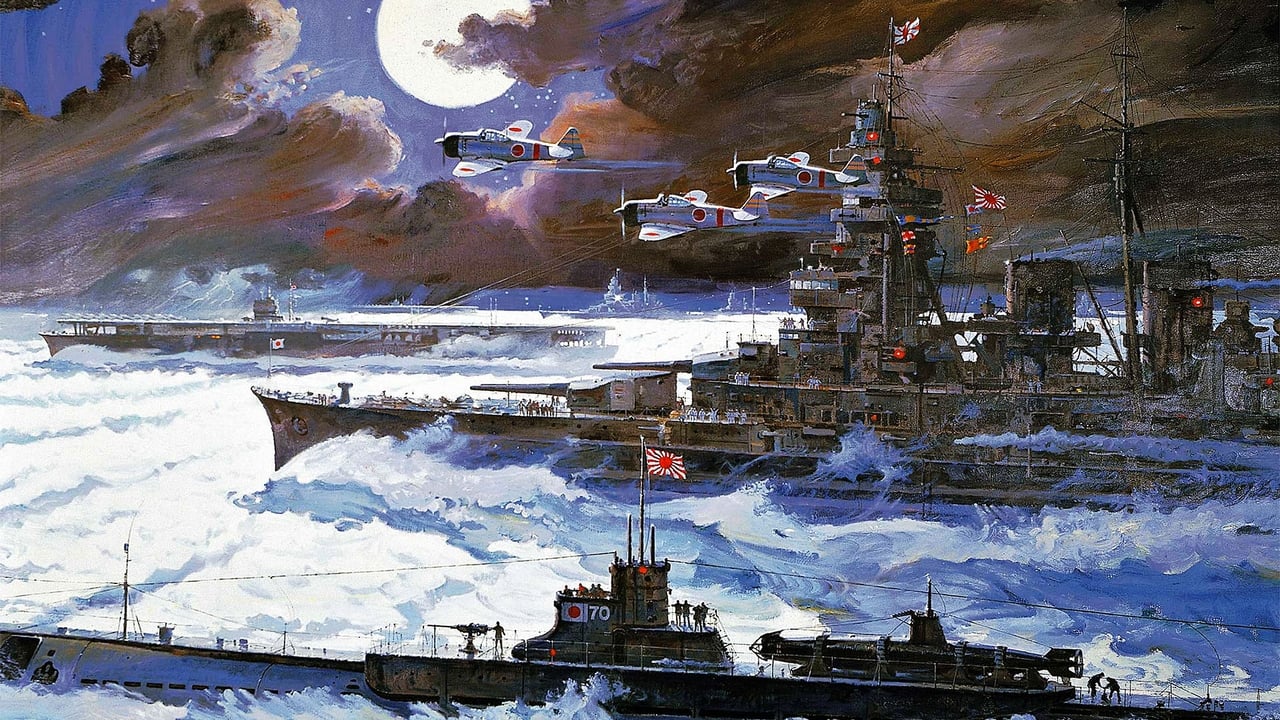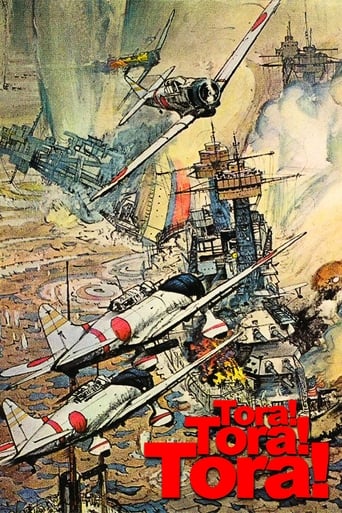

Amateur movie with Big budget
... View MoreThe movie's neither hopeful in contrived ways, nor hopeless in different contrived ways. Somehow it manages to be wonderful
... View MoreLet me be very fair here, this is not the best movie in my opinion. But, this movie is fun, it has purpose and is very enjoyable to watch.
... View MoreThere is, somehow, an interesting story here, as well as some good acting. There are also some good scenes
... View MoreIt takes some courage to take an event that is such a wound to the psyche of the American people and give it an alternative perspective. This is not to accept the motivations of the Japanese Empire, but it gives a reasons for why Pearl Harbor happened. I'm hoping that contemporary society doesn't use the insipid movie "Pearl Harbor" as a benchmark for an understanding of this event. We all know that at some point, someone dropped the ball. It would have been surprising if someone had not. There were too many cooks and an arrogance that left the door open. Through some excellent research, the producers have allowed us inside the planning stages that led to the bombing. There was plenty of warning. There were just too many layers here. As this film goes along it accomplishes what every film aspires to. It makes us think we are watching actual historical figures in action, in a kind of documentary.
... View MoreLet me first say that this is one of the most accurate war movies I've seen to date (and I've seen a lot). I'm a stickler for authenticity when it comes to historical pieces and I also believe that stories about the likes of Pearl Harbor and Titanic are interesting enough without inserting an unnecessary love story. That's where this movie shines. The attention to detail spent on recounting the minute by minute events leading to the attack let you see how the attack on Pearl Harbor occurred. Interestingly enough, where this movie "failed" is to a point where Michael Bay's version shined. NOT the love story part. But during the attack in Bay's version, he accompanies the attack with well placed scores that pull you into the gravity of the situation. In Tora! Tora! Tora! It's well..just an attack. Some movies do really well without scores backing them (Saving Private Ryan) but typically these movies have brilliant visuals and cinematography that circumvent the lack of music. This movie IMHO desperately needed something to bring you into the film. As great as the visuals were for 1970, I just didn't feel "apart" of the attack. I didn't feel anything. It just kind of happened and then it was kind of over. Even as the varying commanders came to realize their blunders, that just watched in stoic fashion. I think this movie is great. However I think far too much focus was put into being authentic that they forgot "we still need to make it entertaining" and simply put- it's not that entertaining. Interesting, but not entertaining if that makes sense. If you want action and sappy love stories watch Bay's version. If you want the detailed historically accurate version, watch Tora! Tora! Tora!
... View MoreForget the junk movie Pearl Harbor by Jerry Bruckheimer that everyone keeps comparing to this one. This movie is better in every way, historically speaking and cinematic. Its acting is better, its accuracy is better and it's attack scenes are better. Unlike Pearl Harbor, this needed no computer animation whatsoever. No second is wasted.Tora! Tora! Tora! is an enjoyable movie even though the Americans seem helpless in the attack. The Japanese just keep bombing and bombing. The explosions in the attack are greatly constructed as are the death scenes of characters. One thing that I like the most about this movie is how it is shown from both point of views.
... View More"Tora Tora Tora" is one of the best war movies & historical dramas ever made. It has the ability to create an incredible tension, as events leading up to the attack unfold; which is all the more remarkable for a rather straightforward retelling of a historic event that everyone has at least a passing familiarity with. "Tora" is actually 2 movies in 1. The Japanese side, filmed in Japan using Japanese actors & crew, and the American side. Producer Elmo Williams & director Richard Fleischer then edited them together, showing the unfolding events as seen from both Japanese& American eyes. Reading the backstory of this production, I found out that 20th Century-Fox's Darryl Zanuck had been interested in this project back to the time he made "The Longest Day", but several issues(including Zanuck's celebrated "Cleopatra" that nearly bankrupted the studio) kept it in "project" stage for years. Also, Japan's premier film director Akira Kurosawa (best known for "The Seven Samurai") was originally engaged in writing & directing the Japanese portion. Considering Kurosawa's immense talent, it's odd that reportedly both Richard Zanuck (who took over running Fox from his father) and Elmo Williams were hugely disappointed with the rushes that were arriving from Japan. According to several credible sources, Kurosawa shot hours of footage, but Fox found they couldn't utilize any of it! Apparently Kurosawa was given large reign over writing the Japanese storyline, and took it off in directions Fox didn't like. Finally Kurosawa was fired, and they brought in a couple of journeymen directors to get the story in the can! One of the things which made for such realism was the Japanese built 2 life-size ship models/sets - of the carrier "Akagi" & the battleship "Nagato" (respectively, Nagumo's and Yamamoto's flagships) for filming key scenes. I've read where these 2 huge models became big tourist attractions while the Japanese sequences were being filmed. They were built right on a beach so that in the distance the ocean would be seen. I've been unable to find out definitively what happened to these giant sets, but I assume they were broken-up after filming was completed. I recall that in an issue of "Sea Classics" magazine after the movie's release it was reported that some of the large models of U.S. battleships used in the filming (in the 25-30 foot range) were being auctioned off. For the USS Arizona, they actually built a full-scale mock-up of the stern of the battleship, which was placed in "battleship row" not far from the Arizona Memorial."Tora" also benefited from being made near enough in time to WWII that many old U.S. aircraft could be used in the film, and many old prop trainers were modified to serve as Japanese types. The special effects still hold up rather well, considering this was pre-CGI. I found many of the attack sequences (esp. those on the airbases) more convincing than the CGI used in 2001's "Pearl Harbor"! And, as far as story goes, there's simply no comparison. "Tora!" is realistic, and yet does manage to briefly show the exploits of the 2 real Army Air Force pilots who managed to get airborne and down some Japanese planes (Lts Welch and Taylor). There's no Ben Affleck & Josh Hartnett dogfighting among the battleships' masts or airfield hangers, or playing "chicken" with each other to lead Japanese planes to crashing into one another! Special credit must go to the "ensemble" character of the cast. Fox avoided making a "spot the star" picture, such as their own "The Longest Day", and concentrated on character and story. Some quality old actors (such as George Macready, Joseph Cotton, and Leon Ames), "secondary types" such as Martin Balsam, Jason Robards, and James Whitmore; and stalwart character actors like E.G. Marshall, Wesley Addy, Frank Aletter, Richard Erdman, Richard Anderson, Neville Brand, and many more. While many of the actors bear no more than a passing resemblance to their real-life counterparts (such as Balsam to Adm. Kimmel), George Macready is very close to Secretary of State Cordell Hull, as are the Japanese actors who play opposite him as Ambassadors Nomura and Kurusu. One of the best-rendered and powerful scenes is where Hull receives the Japanese ambassadors just after he gets word of the Pearl Harbor attack. He gives them an icy dressing-down, then folds his hands and stares down at his desk as the Japanese depart. Another is the much-remembered scene at the end where Admiral Yamamoto points out to his assembled officers that the attack came 55 minutes BEFORE Japan's declaration was delivered in Washington, and tells them that he "fears all they have done is to awaken a sleeping giant and filled him with a terrible resolve." The movie ends with a somber restating of the main theme, showing a troubled Yamamoto gazing out over the sea, then dissolves to the flaming, smoking wrecks at Pearl Harbor, as the end credits role.Composer Jerry Goldsmith, one of the true "greats" of Hollywood, must get much credit, as well. Goldsmith was the master of percussion (such as his unusual but effective "Planet of the Apes" score), and used percussion to create a Japanese-themed score that helps build tension. Such music follows intel officers E.G. Marshall and Wesley Addy as they try to get someone in Washington to believe an attack on Pearl Harbor is imminent. No where is Goldsmith's mastery of setting score to scene better displayed than the final scene before intermission, where Adm. Stark (Edward Andrews) is at his desk in Washington, hesitating about whether to phone Hawaii with warning of the attack or not. We hear his desk clock ticking louder and louder as he looks down at his desk calendar with the iconic "Sunday, December 7, 1941" date, and Goldsmith adds strings, which joins with clock ticks, steadily rising to a crescendo. One of the last chances to warn the Navy in Hawaii is draining away. Dynamite filmmaking and film scoring!
... View More